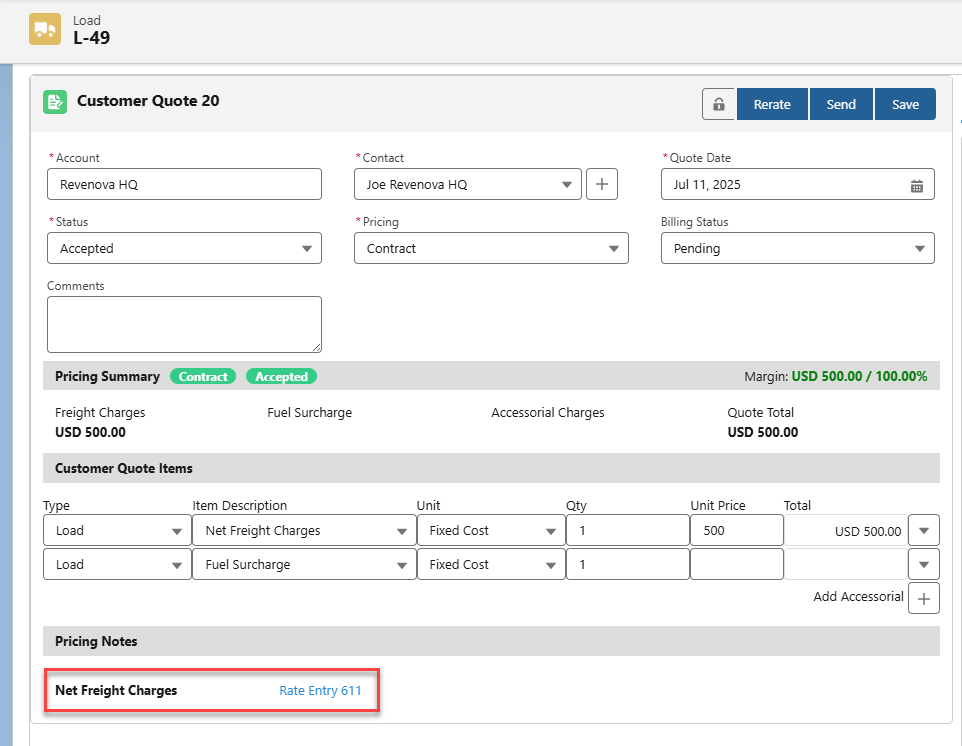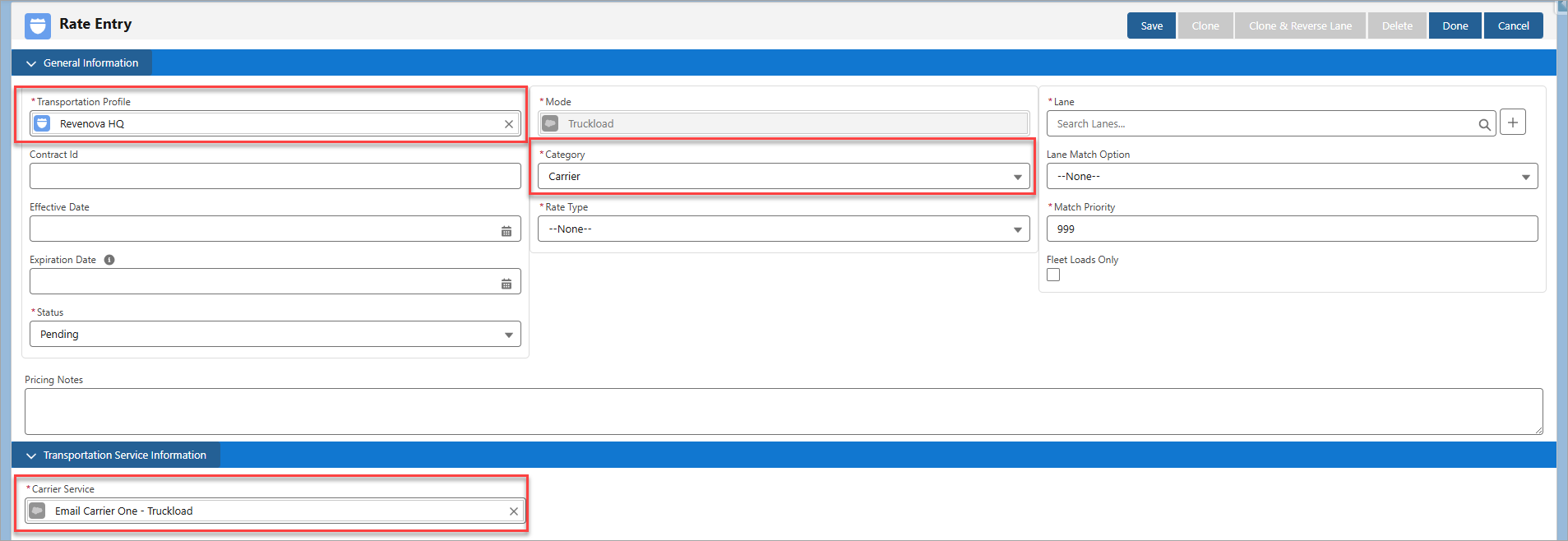When a Load is created and updated, different Transportation Profiles can impact the process for several records:
The Stop Location Account’s Transportation Profile
The Customer Bill To Account’s Transportation Profile
Note: The Location field in the Stop object and Customer Bill To field in the Load object are both Account lookup data types. However, it is the Transportation Profile connected to the Account that will impact the Load process.
Load Object
The Customer and Carrier Transportation Profile impacts the creation and update of a Load object.
Load Creation
During Load creation, the Load object inherits some fields and related records from the Customer Transportation Profile:
Customer Transportation Profile | Load | Data Type on Load |
|---|---|---|
Payment Terms | Payment Terms | Picklist |
Default Customer Bill To | Customer Bill To | Lookup(Account) |
Tax Exempt | Tax Exempt | Checkbox |
Customs Broker (Record) | Customs Broker (Field) | Lookup(Account) |
See the Customs Brokers article for more information about setting up customs brokers for cross-border loads.
Payment Terms Note: If the Customer Transportation Profile has a blank value for the Payment Terms field, the logic cascades to the Global Default Transportation Profile and uses that value for the Load’s Payment Terms field instead. If both Transportation Profiles have a blank value for Payment Terms, the Load’s Payment Terms field is determined by the Product Configuration Global Setting.
Load Update
When a Load is tendered to a Carrier, the Carrier Remit To field on the Carrier Transportation Profile populates on the Load.
Stop Object
The Stop Location Account’s Transportation Profile impacts the creation and update of the Stop object.
Stop Creation Only
During Stop creation only, the Stop object inherits some fields from the Location Account’s Transportation Profile, depending on whether the Stop is a Pickup or a Delivery stop:
Customer Transportation Profile | Stop | Data Type on Stop |
|---|---|---|
Pickup Appointment Required | Appointment Required | Checkbox |
Delivery Appointment Required | ||
Default Pickup Instructions | Instructions | Long Text Area(2000) |
Default Delivery Instructions |
See the Stop Configuration Detail article for more information about creating stops during Load configuration.
Stop Creation and Update
During Stop creation or update, the Stop object inherits either the Shipping Hours or Receiving Hours field from the Location Account’s Transportation Profile and populates it in the Stop object's Shipping/Receiving Hours field.
Customer Transportation Profile | Stop | Data Type on Stop |
|---|---|---|
Shipping Hours | Shipping/Receiving Hours | Text(11) |
Receiving Hours |
Load Accessorials
For every Stop Location Account’s Transportation Profile, if the Transportation Profile has defined Default Accessorials, those accessorials may automatically be added to the Load Accessorials related list in the Load record.

Warning: Some accessorials depend on whether the Stop is a Pickup or Delivery. If the Transportation Profile has a Delivery Default Accessorial (for example, Lift Gate Delivery) but the Stop is a Pickup, then the Default Accessorial is not added to the Load Accessorials related list.
For example, when configuring a Stop and you select either Same as Customer or Account Address and then select an Account in the Location field, the TMS will go to the Transportation Profile associated with the selected Account.
If the accessorial’s type matches the Stop’s type (Pickup or Delivery), then that Default Accessorial record will be added to the Load Accessorials related list for the Load.
The Default Accessorials article contains more information about configuring default accessorials for a Transportation Profile.

Rate Entries
Rate entries stored in the Transportation Profile are searched for and used to construct quotes for a Load automatically.
The Rating Source field in the Transportation Profile determines whether to search for matching rates only in the Customer Transportation Profile or for rates in the Global Default Transportation Profile.

For more information about rate entries, see the Rate Entry Detail article.
Customer Quote Auto-Creation
Rate entries with the Category field as Customer are stored in the Customer Transportation Profile in the Customer Rate Entries related list.

The matches for customer rate entries start in the Customer Transportation Profile. If the customer on the load has customer rate entries with a Lane that matches to the Load, then those rate entries are used to construct the customer quote automatically.

Suppose the Rating Source field in the Customer Transportation Profile is set to Customer + Global Rates and there are no customer rate entry matches in the Customer Transportation Profile. In that case, the matches for customer rate entries are also searched in the Global Default Transportation Profile.
Note: For multiple Customer Rate Entries in a Transportation Profile that matches a Lane, see the Stored Rate Support article for more details.
Carrier Quote Auto-Creation
Rate entries with the Category field as Carrier are stored in the Customer Transportation Profile in the Carrier Rate Entries related list. The Carrier Service field is additionally required to create a carrier rate entry.

The matches for carrier rate entries start in the Customer Transportation Profile. If the customer on the load has carrier rate entries with a Lane that matches to the Load, then those rate entries are used to quote the carrier automatically.
For example, you can see if you successfully quoted a carrier automatically with a Carrier Rate Entry with a success toast message:

If the Rating Source field in the Customer Transportation Profile is set to Customer + Global Rates and there are no carrier rate entry matches in the Customer Transportation Profile, then the matches for carrier rate entries are also searched in the Global Default Transportation Profile.
Note: For multiple Carrier Rate Entries in a Transportation Profile that matches a Lane, see the Stored Rate Support article for more details.
Carrier Exclusions
If the Customer or Global Transportation Profile searched and matched has a Carrier record in the Carrier Exclusions related list, then that carrier is not considered when automatically generating carrier quotes with rate entries.

Customer Invoice
When a Customer Invoice record is generated, some fields are inherited or populated from the Customer Bill To Account’s Transportation Profile from the Load:
Customer Transportation Profile | Customer Invoice (Field Name) | Data Type on Customer Invoice |
|---|---|---|
POD Required | POD Required | Checkbox |
Billing Method | Billing Method | Picklist |
Customer Invoice Day | Invoice Date | Date |
Invoice Terms | Invoice Due Date | Date |
For more information about the Customer Invoice fields populated from the Customer Transportation Profile, see the Customer Invoice Generation article.
Load Tendering
The Customer Transportation Profile impacts the document tendering process for a Load. If the Customer Transportation Profile doesn’t define the logic, then it cascades to the Global Default Transportation Profile.
If the Bill of Lading document is tendered, then the Carrier Transportation Profile impacts certain document fields.
Field: Tender Documents
The Tender Documents multi-select picklist field in the Transportation Profile determines the documents emailed to the carrier during load tendering.

If the Customer Transportation Profile has values in the Tender Documents field, then those documents will be tendered to the carrier.
If the value is blank in the Customer Transportation Profile, then the logic cascades to the Global Default Transportation Profile and uses that value to tender documents instead.
If both Transportation Profiles have a blank value for the Tender Documents field, the Product Configuration Global Setting determines which documents to tender for the load.
Field: SCAC
If the Bill of Lading document is tendered and the SCAC field in the Carrier Transportation Profile has a value, then that field is displayed on the document.
.png)